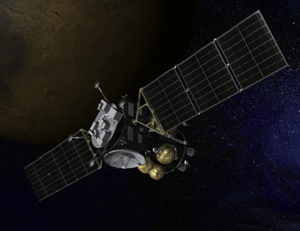
Martian Moons eXploration (MMX)
NSSDCA ID: MMX-MARS
Description
The Mars Moon eXploration (MMX) mission is a JAXA (Japan) spacecraft planned to launch in the mid-2020s to study the martian moon Phobos and collect a sample from the surface for return to Earth. The scientific objectives are to investigate whether the martian moons are captured asteroids or fragments that coalesced after a giant impact with Mars; to acquire new knowledge on the formation process of Mars and the terrestrial planets; to clarify the mechanisms controlling the surface evolution of the martian moons and Mars, and to gain new insights into the history of the Mars system. It also has the goal of improving technology for future planet and natural satellite exploration, round-trip procedures, and sampling techniques.
MMX will comprise three modules: a return module with a mass of approximately 1350 kg, an exploration module (150 kg), and a propulsion module (1990 kg), for a total mass of about 3400 kg. All masses include propellant. The three modules are configured with the propulsion module on the "bottom", the return module mounted above it, and the exploration module on top of that. Communications will be through a high-gain dish antenna mounted on the side of the return module. Power is provided through two solar panel wings. Propulsion is via a 500 N class orbital maneuvering engine (OME), attitude control will use a 20 N class reaction control system (RCS). The lander is equipped with four landing legs and a sample container. The spacecraft lander, the Exploration Module, is equipped with a corer to be able to collect samples from deeper than 2 cm, as well as an ion mass spectrometer and a dust counter. MMX will also carry a camera, LIDAR, near-infrared spectrometer, and gamma-ray/neutron spectrometer.
The current plan is for a launch around November 2026 on the H-3 rocket (currently under development) to arrive at Mars roughly one year later. MMX will first go into orbit around Mars in 2027. After making observations of Mars and its moons from this orbit it will proceed to a Quasi-Satellite Orbit (QSO) around Phobos, from which it will continue observations. The Exploration Module will then land on Phobos and collect a roughly 10 g sample from the surface and subsurface during a stay on the moon of a few hours. It will bring the sample back to the Return Module, which will bring the sample to Earth in 2031, landing in the Woomera Prohibited Zone in Australia.
Image credit: ISAS/JAXA
Alternate Names
- MMX
- MartianMoonseXploration(MMX)
Facts in Brief
Launch Date:
Launch Vehicle:
Launch Site: , Japan
Mass: 3400 kg
Funding Agency
- Japan Aerospace Exploration Agency (Japan)
Discipline
- Planetary Science
Additional Information
- Launch/Orbital information for Martian Moons eXploration (MMX)
- Telecommunications information for Martian Moons eXploration (MMX)
Questions and comments about this spacecraft can be directed to: Dr. David R. Williams
Personnel
| Name | Role | Original Affiliation | |
|---|---|---|---|
| Dr. Yasuhiro Kawakatsu | Program Manager | Institute of Space and Aeronautical Science | Kawakatsu.Yasuhiro@jaxa.jp |

